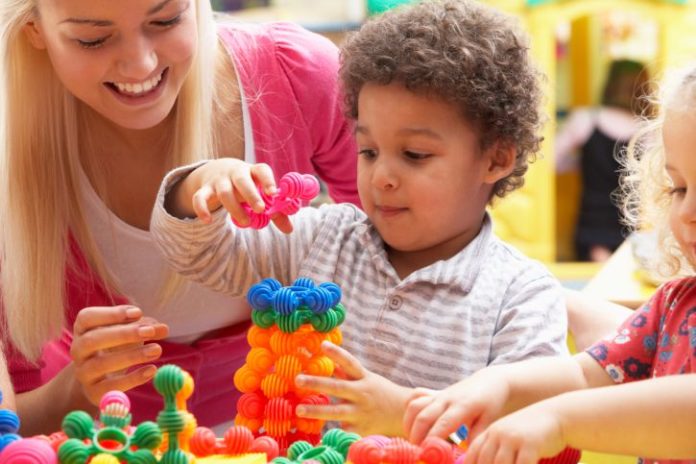Make use of the toy corner
It’s often also possible for resourceful parents to access free toys. Many public spaces like service organisations and libraries provide toys for children to play with. If your local library has a toy section, why not make a weekly visit and let your child play for an hour or two? Service organisations like banks often have toy corners that children can use while parents are in the queue. You can’t take these toys home with you but can have lots of fun playing while you’re out and about.
Next time you’re meeting up with friends for coffee or lunch, choose a family friendly restaurant or cafe with a well-equipped toy corner where the kids can play ‘til their hearts are content (and leave you and your girlfriends free to gossip ‘til your hearts are content). Look for toy areas which are gated so you’ll know the kids can’t wander off.
Before allowing your child to access public toys, talk to them about respecting the toys they find, playing with them gently and sharing with the other children who are playing. You could also show your appreciation by donating kids toys your child has outgrown.
Try a toy swap
Toy swapping is another ‘free toys’ option. This would work well with parents in your parent’s or mother’s group, playgroup or with family who have similarly aged children to your own. With a swap, they can enjoy playing with some toys which are ‘new’ to your child, and when they get their ‘old toy’ back from the swap it will have resumed some of its interest again. This is a great way to get your child in the habit of sharing the things they love.
Bear in mind that sometimes are damaged, so it’s probably best to advise your child not to lend their favourite toys. Ground rules are particularly important in this situation, to ensure that borrowed toys are returned in the best possible condition. Ask others in the group to ensure the toys they borrow are cleaned before they’re returned. For battery operated toys, decide in advance who is responsible for replacing worn out batteries (e.g. the child who is using the toy when the battery runs out or the person who owns the toy). You might also agree in advance with other parents what to do if toys get damaged.
 Make a playdate
Make a playdate
Access some different toys by going on a playdate to another child’s house and your child will enjoy having social interaction and accessing some new toys. Inviting children to your child’s house to play will also make their own toys seem more interesting again.
Free toys to keep
There may be some occasions, for example birthdays or Christmas, when you want to get your child a toy they can keep. If you’re having financial difficulties (and let’s face it, many parents do from time to time) registering with a local charity organisation might be a good idea. Many organise Christmas toy drives, so that people can donate a new toy for a child of a particular sex and/or age. The toys are then distributed free to children who need them. If you do receive toys from a charity, you may want to volunteer your time to help out and show your appreciation, or donate toys in the future when your circumstances improve.
You may also be able to find free second hand toys in good condition on the footpath. Many councils in Australia have regular curb side collection or clean up days. Households can leave items they are throwing away that don’t fit in the bin. Find out when council clean up happens in your suburb (or the rich neighbouring suburb if you can get there) and go looking for freebies. You will need to check there in good working order and your child won’t hurt themselves, but it’s not unusual to find perfectly good (sometimes almost brand new) toys on the roadside. You might find trikes and bikes, kid’s furniture and outdoor play equipment. It may need a good clean or a coat of paint to spruce it up but that’s bound to be cheaper than buying the toy.
The joy of giving
You could organise with other parents to pass toys that children have outgrown onto families with younger children or families in need. Many charities accept toy donations and other parents you know will probably also be happy to accept them. They say that what goes around comes around, so encouraging children to pass on toys they’ve outgrown may just mean they end up getting back some free kids toys as hand-me-downs from another child. Whether you’re exchanging old toys or giving them to a charity, make sure you involve your child in deciding which toys to give away.
What to do with toys your child has outgrown
Children outgrow toys fairly quickly, and unless your child has a little brother or sister who can use the toys they’re too big for, you’ll probably be happy to get rid of the old toys and make room for new ones. Kids usually outgrow their toys before they’ve worn them out (and sometimes before they’ve even properly worn them in!), so you’ll want to make sure they find their way into the hands of another child. There are a few options.
You could donate toys to a charity (it might be the local op shop or school fete). This way you’ll have the satisfaction of knowing that your toys end up helping another child learn and have fun and that the money made from reselling your child’s toys ends up with a charity.
If you need a few extra bucks in your new toy budget, why not sell your old kids toys online? Or book a stall at the weekend market where you can sell them. If you don’t have enough for an entire stall, you could add some second hand clothes or team up with some other mums who have toys needing a new home.
References
 |
Where to find toys that are fun and educational. |
 |
Where to find cheap toys for your child. |
 |
Make your own toys at home. |
 |
Choosing the right toys that are age appropriate. |



 (7 votes, average: 4.43 out of 5)
(7 votes, average: 4.43 out of 5) 






